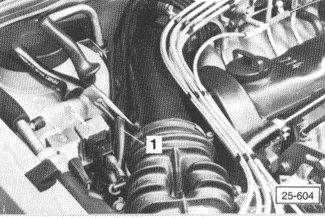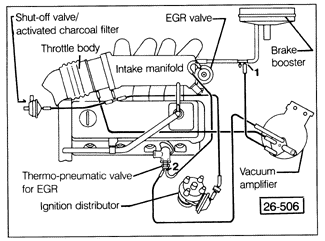Testing EGR System (Canada models only)The EGR valve should open only under part-throttle vacuum. A rough idle may indicate that the valve is incorrectly opening at idle. To check, loosen the union and disconnect the EGR line to the exhaust manifold at the bottom of the EGR valve. Then plug the open bottom port of the EGR valve. If the idle smooths out, it is because the valve was leaking and should be replaced.
The normal part-throttle operation of the EGR valve is tested by artificially supplying vacuum to the valve and observing the response. Pinch shut the hose leading from the idle speed boost valve to the throttle body as shown in Fig. 6-1. Remove the vacuum line from the thermo-pneumatic valve and temporarily reconnect it to a vacuum port on the brake booster line. See Fig. 6-2.

At normal operating temperature with the vacuum lines connected as described, the engine should idle roughly or stall. If not, loosen the union and disconnect the EGR line from the bottom of the EGR valve. If the idle then becomes rough the EGR valve is operating correctly, but the line to the exhaust manifold is clogged and should be cleaned or replaced. If the idle is still smooth, then the EGR valve is defective. To replace the EGR valve allow the engine to cool, then disconnect the vacuum line and the EGR line to the exhaust manifold. Use a hex wrench to remove the two socket-head mounting screws. Install the new valve with a new gasket, using a high-temperature anti-seize lubricant on the screw threads. Reconnect the EGR line. Reconnect the vacuum lines as shown in Fig. 6-2.

To test the thermo-pneumatic valve, locate the two vacuum lines leading from the thermo-pneumatic valve as shown in Fig. 6-2 above. Disconnect these vacuum lines from the EGR valve and from the vacuum amplifier. Blow into one and listen for airflow from the other. With the engine coolant temperature below 112°F (45°C), no air should pass through the valve. With the engine at normal operating temperature, air should pass through the valve. If the valve appears to be faulty, first check for damaged or kinked lines. If the vacuum lines are clear, the valve is defective and should be replaced. If the thermo-pneumatic valve must be replaced, use a new sealing washer. Use a sealing compound on the threads of the new valve. Reconnect the vacuum lines. Some engine coolant may leak out when the valve is removed. If so, check and correct the coolant level as described in LUBRICATION AND MAINTENANCE. |